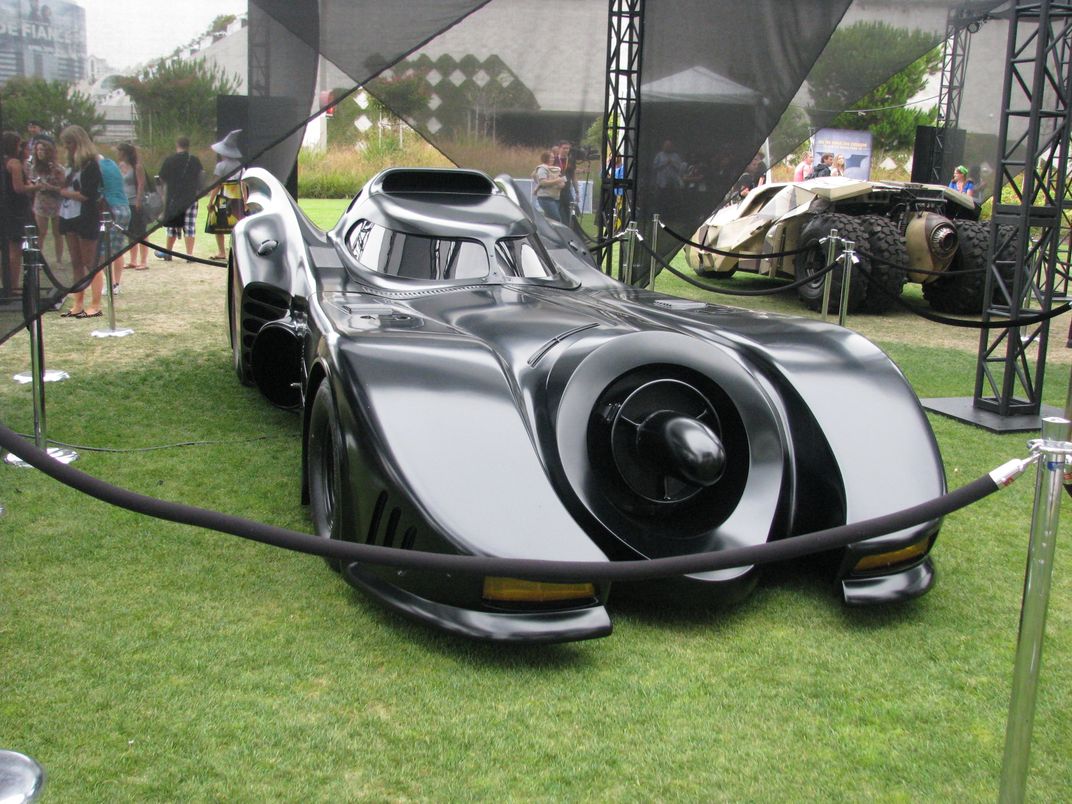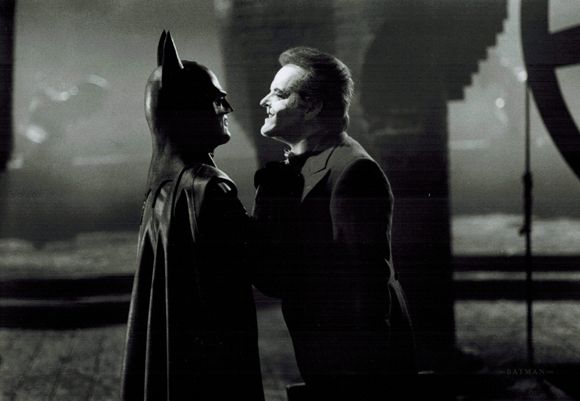What the Batmobile Tells Us About the American Dream
Fans of DC Comics will go batty for this new installation at the National Museum of American History
:focal(2035x844:2036x845)/https://tf-cmsv2-smithsonianmag-media.s3.amazonaws.com/filer/85/11/8511b628-6319-4d31-aab7-7f4f2abc948f/batmobile7.jpg)
Few figures of American pop culture have cast shadows as long as that of DC Comics’ Dark Knight. Every year, fresh material is added to the Caped Crusader corpus, ranging from the madcap comedy of Adam West’s classic TV show and the LEGO Batman franchise to the gritty drama of Christopher Nolan’s films and the critically lauded Batman: Arkham video game series.
Whether he’s bantering with the Boy Wonder or breaking the bones of baddies, we can’t seem to get enough of this guy. There is something perennially mysterious about the cowled crime-fighter, and something viscerally American in the way he dispenses justice.
Batman also epitomizes the concept of cool, thanks in large part to his vast assortment of tailor-made gadgets.
Scaling sheer walls with a grapnel gun, gliding through the night in a state-of-the-art wingsuit, disarming foes with Batarangs. . . nothing is out of the question for the constantly tinkering hero. His most famous invention of all is the Batmobile, a sleek means of rapid transport that comes equipped with a suite of defensive, offensive and computational capabilities.
One of the most arresting renderings of the vigilante’s vehicle graced the eerie art deco Gotham of Tim Burton’s 1989 film Batman. For the next three years, the full-scale Batmobile seen in that movie is on view at the Smithsonian’s National Museum of American History, on loan from Warner Bros.
“I’m in the fortunate position of being one of the curators to work on our entertainment and popular culture collections,” says the museum’s Eric Jentsch, “and one of the things we want to do is really show how these kinds of cultural phenomena like Batman become part of the shared experience of American life, and are therefore worthy of investigation and exploration.”
In order to understand why a fictional automobile is deserving of recognition in a museum devoted to American “ideas and ideals,” you first need to wrap your head around the broader appeal of Batman, then consider the ways in which the hero’s signature ride reflects on both his character and the consumers of that character.
Batman buff Matt Yockey, author of the 2014 book Batman, was delighted to walk down this analytical path in a recent interview with Smithsonian.com.

“Batman,” Yockey contends, “is particularly popular, and so enduring, because he resolves the inherent contradictions in American identity.” Since its formative years, he says, the country has embraced a paradoxical philosophy of unity through collective individualism. By looking out for ourselves, we look out for our society. Batman, who battles his personal issues by battling crime in Gotham, is the perfect embodiment of this. “Batman is the ultimate individual,” Yockey says, “but he’s always working for the good of the larger social body. So you get to have it both ways with Batman.”
Another selling point for consumers is that Batman is less of a superhuman and more of a super human. Bruce Wayne’s wealth may afford him the opportunity to develop high-tech gadgetry, but all the money in the world could never silence the demons in his mind. The double murder of Wayne’s parents, which led him to adopt the alter ego of Batman, is always present in his subconscious, eating at him. In order to succeed, he must face down his darkest fears night in and night out. “He has to earn everything that he does emotionally and psychically, because of that trauma,” Yockey says.
Seeing a rich man struggle with loss would have been especially therapeutic for the readership of the first-ever Batman comics, Yockey notes, which came out in the twilight years of the Great Depression. One can understand, too, why this sort of character would have lasting appeal—class tension is always a topical issue.
In those very first comics, Batman was deeply flawed, by no means the principled warrior we tend to think of today. Drawing inspiration from the grisly noir stories of pulp magazines like Black Mask, his creators depicted him as a broken and brutal character. “He has guns, he shoots criminals, he breaks their necks,” says Yockey. “He’s pretty vicious.”
Before long, though, DC Comics decided that they would do well to brighten the story somewhat, to make the comics more child-friendly and stave off parental protests. To this end, the editors eighty-sixed the murders and introduced a sidekick named Robin, who would act as a sort of surrogate son to Batman. And in place of guns and knives, snazzy futuristic gadgets emerged—among them the Batmobile.

“It’s not named the Batmobile until February of 1941,” Yockey says. Before then, in the pulpy first year of the character, Batman had tooled around in an unnamed, humdrum red sedan—a choice that in retrospect seems completely incongruous. Once the comic book writers settled on calling it the Batmobile, says Yockey, they revamped its look too, arriving at something much more recognizably Batman. “It becomes dark blue, it has a fully enclosed top, it has a bat head front and a single shark-like fin in the back, and it’s just presented as a super souped-up car.”
This Batmobile concept was revised somewhat in 1950, when a convenient wreck in the comics mandated that Batman and Robin build themselves a replacement. The upgrade was even sexier than the original, boasting a powerful searchlight, additional horsepower, a transparent bubble cockpit and ample onboard tech (including a forensics lab and radar display). Its basic message to readers stayed the same: this was a vehicle to envy.
Just as Batman straddles the American duality of radical individualism and conformity to a larger mission, so too, argues Yockey, does his Batmobile. From practically the onset of automobile marketing in the U.S., he says, consumers were presented with visions of “a mass-market item that, through your ownership of it, you can use to express your individuality.” Batman’s sweet ride can be viewed as the culmination of this postwar dream.
“This is the ultimate custom car,” says Yockey. It is Batman’s uniquely—nobody else’s. And yet, “the Batmobile becomes his primary tool to defend the community” of Gotham. Once again, the comics reinforce for us the idea that individual achievement and individual style can be agents for community improvement—a thoroughly American sentiment.
The first time the Batmobile appeared on screens was in the late 1960s, when it was featured prominently in the campy-to-the-max ABC TV series Batman, starring Adam West. Batman downplayed the darker aspects of the character, focusing for the most part on light, loony adventure scenarios with Robin. Yockey says the Batmobile became a sort of toy in this context. Indeed, it was sold as a real-life toy in miniature form in stores across the country.
Visionary filmmaker Tim Burton, who helmed 1989’s feature-length Batman—starring Michael Keaton in the title role and Jack Nicholson as the Joker—had a very different notion of the Batmobile, the Batman, and Gotham City as a whole. Pleasing to fans who had found the Adam West incarnation of the character altogether too silly given the original material, Burton’s Batman was much more closely attuned to the earliest, darkest versions of the character than to the one liner-spewing Caped Crusader of the 1960s.
Burton’s broad imagining of a dark, dreamy, historical Gotham City was brought to life by British-born production designer Anton Furst, who won an Academy Award for his work on the film. Furst’s attention to detail in sculpting a setting rife with the stark geometry of gothic and art deco architecture ensured that Gotham became a character in its own right. And when he developed the sleek, slender look of Batman’s Batmobile, Furst was sure to bear the larger city in mind, and to set the two in conversation with one another.
“It looks radically different from the Adam West Batmobile,” Yockey says. “It’s got this strange art deco design to it that visually quite directly links it to the art deco design of Gotham City in the film.” This aesthetic parity between the signature car of Batman and the city he serves substantiates the idea that, while no doubt a unique and solitary man pursuing his own goals, he is also standing up for society on a greater scale. “It’s such a reflection of the city Batman protects,” Yockey says. And “it literalizes and materializes the fact that the city itself produced Batman.”
There have been additional noteworthy interpretations of the Batmobile in the years since—including Christopher Nolan’s hulking, tank-like Tumbler—but the one conceived by Anton Furst for Burton’s Batman remains to many fans the gold standard. It conveys both Batman’s connection to the world of the everyday and his distance from it, his heroism and his abiding darkness. “That dark place in all of us, the id, is where Batman emerges from,” Yockey says. “And I think that’s an important reason why he’s so popular.”
Curator Jentsch is delighted to be able to share such a complex icon of Americana with museumgoers. “We know our visitors are fascinated by the subject,” he says, “and this is an opportunity to give them a really great object to get excited about, and get them thinking about entertainment” in this country.
/https://tf-cmsv2-smithsonianmag-media.s3.amazonaws.com/accounts/headshot/DSC_02399_copy.jpg)


/https://tf-cmsv2-smithsonianmag-media.s3.amazonaws.com/accounts/headshot/DSC_02399_copy.jpg)